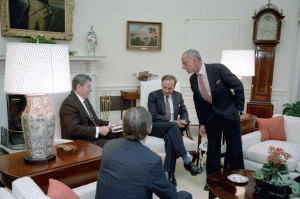Another document, entitled "Project Truth Enhancement," described how $24 million would be spent on upgrading the telecommunications infrastructure to arm "Project Truth, with the technical capability to provide the most efficient and productive media support for major USG policy initiatives like Political Democracy." Project Truth was the overarching name of the Reagan administration's propaganda operation. For the outside world, the program was billed as "public diplomacy," but administration insiders privately called it "perception management." [See Consortiumnews.com's "The Victory of Perception Management."]
The Early Years
The original priority of "Project Truth" was to clean up the images of the Guatemalan and Salvadoran security forces and the Nicaraguan Contras, who were led by ousted dictator Anastasio Somoza's ex-National Guard officers. To ensure steady military funding for these notorious forces, Reagan's team knew it had to defuse the negative publicity and somehow rally the American people's support.
At first, the effort focused on weeding out American reporters who uncovered facts that undercut the desired public images. As part of that effort, the administration denounced New York Times correspondent Raymond Bonner for disclosing the Salvadoran regime's massacre of about 800 men, women and children in the village of El Mozote in northeast El Salvador in December 1981. Accuracy in Media and conservative news organizations, such as The Wall Street Journal's editorial page, joined in pummeling Bonner, who was soon ousted from his job. But such efforts were largely ad hoc and disorganized.
CIA Director Casey, from his years crisscrossing the interlocking worlds of business and intelligence, had important contacts for creating a more systematic propaganda network. He recognized the value of using established groups known for advocating "human rights," such as Freedom House.
One document from the Reagan library showed senior Freedom House official Leo Cherne running a draft manuscript on political conditions in El Salvador past Casey and promising that Freedom House would make requested editorial "corrections and changes" -- and even send over the editor for consultation with whomever Casey assigned to review the paper.
In a "Dear Bill" letter dated June 24, 1981, Cherne, who was chairman of the Freedom House's executive committee, wrote: "I am enclosing a copy of the draft manuscript by Bruce McColm, Freedom House's resident specialist on Central America and the Caribbean. This manuscript on El Salvador was the one I had urged be prepared and in the haste to do so as rapidly as possible, it is quite rough. You had mentioned that the facts could be checked for meticulous accuracy within the government and this would be very helpful. ...
"If there are any questions about the McColm manuscript, I suggest that whomever is working on it contact Richard Salzmann at the Research Institute [an organization where Cherne was executive director]. He is Editor-in-Chief at the Institute and the Chairman of the Freedom House's Salvador Committee. He will make sure that the corrections and changes get to Rita Freedman who will also be working with him. If there is any benefit to be gained from Salzmann's coming down at any point to talk to that person, he is available to do so."
By 1982, Casey also was lining up some powerful right-wing ideologues to help fund the "perception management" project both with money and their own media outlets. Richard Mellon Scaife was the scion of the Mellon banking, oil and aluminum fortune who financed a variety of right-wing family foundations -- such as Sarah Scaife and Carthage -- that were financial benefactors to right-wing journalists and think tanks. Scaife also published the Tribune Review in Pittsburgh, Pennsylvania.
A more comprehensive "public diplomacy" operation began to take shape in 1982 when Raymond, a 30-year veteran of CIA clandestine services, was transferred to the NSC. Raymond became the spark plug for this high-powered propaganda network, according to an unpublished draft chapter of the congressional Iran-Contra investigation that was suppressed as part of the deal to get three moderate Republican senators to sign on to the final report and give the inquiry a patina of bipartisanship.
Though the draft chapter didn't use Raymond's name in its opening pages, apparently because some of the information came from classified depositions, Raymond's name was used later in the chapter and the earlier citations matched Raymond's known role. According to the draft report, the CIA officer who was recruited for the NSC job had served as Director of the Covert Action Staff at the CIA from 1978 to 1982 and was a "specialist in propaganda and disinformation."
"The CIA official [Raymond] discussed the transfer with [CIA Director] Casey and NSC Adviser William Clark that he be assigned to the NSC as [Donald] Gregg's successor [as coordinator of intelligence operations in June 1982] and received approval for his involvement in setting up the public diplomacy program along with his intelligence responsibilities," the chapter said. Gregg was another senior CIA official who was assigned to the NSC before becoming Vice President George H.W. Bush's national security adviser.
"In the early part of 1983, documents obtained by the Select [Iran-Contra] Committees indicate that the Director of the Intelligence Staff of the NSC [Raymond] successfully recommended the establishment of an inter-governmental network to promote and manage a public diplomacy plan designed to create support for Reagan Administration policies at home and abroad."
War of Ideas
During his Iran-Contra deposition, Raymond explained the need for this propaganda structure, saying: "We were not configured effectively to deal with the war of ideas."

President Reagan meets with publisher Rupert Murdoch, U.S. Information Agency Director Charles Wick, lawyers Roy Cohn and Thomas Bolan in the Oval Office on Jan. 18, 1983.
(Image by (Photo credit: Reagan presidential library)) Details DMCA
(Note: You can view every article as one long page if you sign up as an Advocate Member, or higher).





